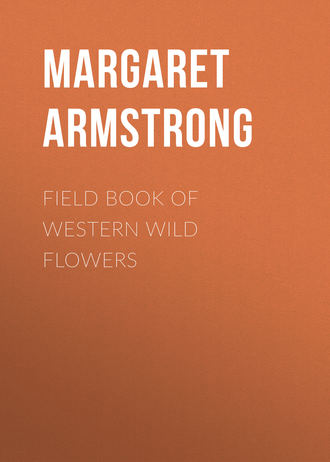 полная версия
полная версияПолная версия
Field Book of Western Wild Flowers
Pink
Summer
California
A branching plant, woody at base, two feet high, with smooth stems; smooth, toothed leaves; nodding buds and large handsome flowers. The petals are pale-pink, about an inch long, the pistil pink, and at a distance the effect of the flower is much like a Mallow. As is usual with Godetias, the sepals are stuck together and stand out at one side, giving the flower a quaint effect of having thrown back a little hood in order to look about. This grows in light shade.
Farewell-to-Spring
Godètia quadrivúlnera
Pink, lilac
Spring, summer
Northwest
This is common in the foothills of the Sierras and Coast Ranges and has a slender stem, about a foot tall, with more or less downy leaves, sometimes slightly toothed, and a few very pretty flowers, about an inch and a half across, with bright lilac-pink petals, usually splashed with carmine. This red spot gives a vivid effect and the delicate flowers look exceedingly gay and charming, as they sway in the wind among tall grasses on open hillsides.
Godètia Góddardii var. capitàta
Pink
Spring, summer
California
From one to two feet tall, with a rather stout, more or less branching stem and soft, rather downy, dull green leaves. The flowers are about an inch across, with purplish-pink petals, often stained with crimson at the tips. This is found on dry hills in the Coast Ranges.
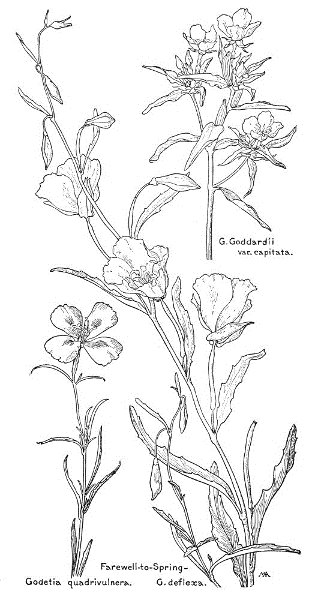
Farewell-to-Spring – G. deflexa.
G. Goddardii var. capitata.
Godetia quadrivulnera.
Godètia vimínea
Purplish-pink
Summer
Northwest
A handsome plant, with nearly smooth, slender, reddish stems, a few inches to two feet tall, and smooth, pale-green, toothless, narrow leaves, mostly without leaf-stalks. The buds are erect and the flowers form a long, loose cluster, with bright purplish-pink petals, half an inch to over an inch long, with a large, magenta blotch near the center, or at the tip, and yellowish at base; the stamens and pistil all purple; the calyx-lobes not caught together, but turned primly back. This forms fine patches of bright color in rather meadowy places in Yosemite and elsewhere in the Sierra Nevada foothills. G. Dudleyàna is pretty and slender, with drooping buds and light lilac-pink flowers, the petals paler at base, with darker dots, the calyx-lobes caught together and turned to one side, and also makes beautiful patches of color on sunny slopes around Yosemite.
There are several kinds of Clarkia, resembling Godetia, but the petals have claws. The stems are brittle; the leaves mostly alternate, with short, slender leaf-stalks; the buds nodding; the flowers in terminal clusters, with four petals, never yellow, and four sepals, turned back; the stamens eight, those opposite the petals often rudimentary; the stigma four-lobed; the capsule long, leathery, erect, more or less four-angled, with many seeds. Named in honor of Captain Clarke, of the Lewis and Clarke expedition, the first to cross the Rocky Mountains to the Pacific, in 1806.
Clarkia
Clàrkia élegans
Pink
Spring, summer
California
A conspicuous plant, on account of the oddly contrasting colors of the flowers, and very variable both in size and smoothness. It grows from six inches to six feet high; the stems more or less branching; the leaves sometimes toothed and often reddish; the buds and calyxes often woolly. The flowers are very gay; the sepals being dark red or purple, the petals, with long, slender claws, bright pink and the anthers scarlet! The stamens, four long and four short, have a hairy, reddish scale at the base of each filament, the anthers of the shorter stamens often white, and the capsule is usually curved, with no stalk, nearly an inch long, often hairy. When the foliage is red, as it often is, the various combinations of red in the flowers and leaves are quite startling. This is common in the foothills of the Sierra Nevada and Coast Ranges and is often rather shabby looking, but in favorable situations is very handsome.
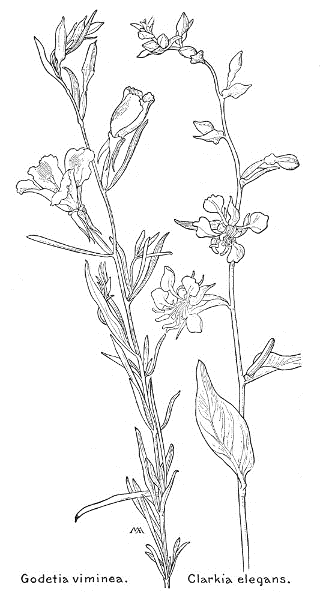
Godetia viminea.
Clarkia elegans.
Clarkia
Clàrkia rhomboídea
Purple
Spring, summer
Northwest, Nev., Utah
Pretty and delicate and not nearly so conspicuous as the last, with a slender, smooth, branching stem, one to three feet tall, with smooth leaves, mostly alternate, nodding buds, and a few pretty flowers, about three-quarters of an inch across. The sepals are reddish-yellow; the petals pinkish-purple, often dotted with purple at base, with a short, broad, toothed claw; the stigma magenta; the filaments purple, with a whitish, hairy scale at the base of each; the anthers grayish, all perfect; the capsule four-angled, slightly curved, about an inch long. This grows in the foothills of the Sierra Nevada and Coast Ranges and is widely distributed in Yosemite, but nowhere very abundant.
Pink Fairies
Clàrkia pulchélla
Pink
Summer
Northwest
Odd and exceedingly charming flowers, with very slender, very slightly downy, purplish, branching stems, from six inches to a foot tall, and smooth leaves. The flowers are fantastic in form, the airiest and most fairy-like blossoms that can well be imagined, over two inches across, their delicate petals with long, toothed claws and three lobes, bright rose-pink, shading to a deeper tint at the base, the calyx slightly downy and reddish. Four of the stamens are perfect and four are rudimentary; the anthers are reddish; the pistil white; the capsule an inch long, eight-angled, with a spreading stalk. It is a pretty sight to see these gay flowers dancing in the wind on open mountain slopes. C. concínna (Eucharidium), of the Coast Ranges, is similar, equally beautiful and even more brilliant in coloring; the flowers sometimes in such quantities as to make patches of bright pink color, very effective when growing among yellow Sedums, Scarlet Larkspurs, and scarlet Indian Pinks, in shady mountain canyons.
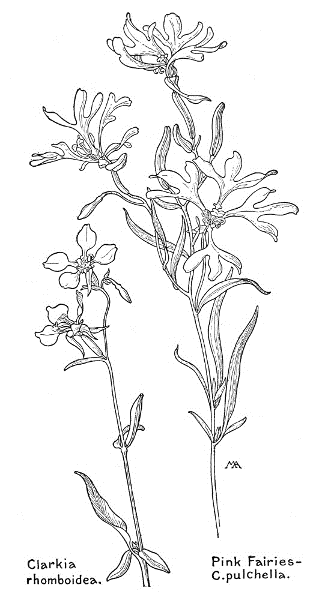
Clarkia rhomboidea.
Pink Fairies – C. pulchella.

There are several kinds of Sphaerostigma; leaves alternate; flowers yellow, white or pink, turning green or reddish; stamens eight, with oblong, swinging anthers; style threadlike, with a round-top stigma; capsule four-celled, usually long and narrow, four-angled, often twisted, with no stalk.
Evening Primrose
Sphaerostígma bistórta (Oenothera)
Yellow
Spring
California
A common kind, very variable in its manner of growth, being tall and erect in moist, shady places and spreading flat on the ground in dry, sunny spots. The leaves are dull green, more or less downy and more or less toothed, and the flowers are three-quarters of an inch across, clear yellow, usually with a speck, or blotch, of reddish-brown at the base of each petal; the stamens and pistil also yellow; the pods reddish and very much twisted. Gravelly washes are often thickly sprinkled with these gay and charming flowers.
Sphaerostígma Veitchiànum (Oenothera)
Yellow
Spring
California
Much like the last, but the flowers are only a little over a quarter of an inch across. The pods are dark red and shiny, with a few hairs.
Beach Primrose
Sphaerostígma viridéscens (Oenothera cheiranthifolia var. suffruticosa)
Yellow
All seasons
California
A beautiful seashore plant, forming large, low clumps of reclining stems and pale gray, downy foliage, the twigs and younger leaves silvery-white. The flowers are about an inch and a quarter across, clear yellow, often with two, dark red dots at the base of each petal; the stamens and pistil also yellow of the same shade; the pods pinkish, downy, and much twisted. The flat masses of pale foliage, strewn with golden disks, are exceedingly effective, growing in drifting sand hills along the coast, from San Francisco south.


S. Veitchianum.
Beach Primrose – Sphaerostigma viridescens.
Evening Primrose – S. bistorta.
Sphaerostígma tortuòsa. (Oenothera)
White
Spring
Nevada
A queer little, stunted-looking, desert plant, with almost no stem, but with several branches, spreading flat on the ground, stiff, smooth and purplish, with crowded clusters of flowers, leaves, and pods, mostly at the ends, the whole forming flat clumps, from six to ten inches across. The leaves are smooth, slightly thickish, pale bluish-green and toothless; the buds are erect, and the flowers are over a quarter of an inch across, white, with yellow anthers and a green stigma. The pods are very much twisted and form odd little snarly bunches.
There are only a few kinds of Chylisma; the flowers in terminal clusters; the calyx with a more or less funnel-form tube and four lobes; the petals four, not notched; the stamens eight, unequal; the stigma with a round top, the capsule long, membranous, with a stalk.
Chylisma
Chylísma scapoìdea var. clavaefórmis (Oenothera)
White
Spring
Ariz., Utah
A charming desert plant, from a few inches to a foot tall, with one or more, pinkish, smooth, rather leafy stems, springing from a pretty clump of smooth, bluish-green leaves. The delicate flowers are about three-quarters of an inch across and form a graceful cluster of several or many blossoms. The petals are white or yellow, often tinted with pink, with some specks of maroon at the base, and the sepals are pinkish-yellow; the stamens pale yellow; the stigma green; the pods erect.
There are several kinds of Pachylophus; perennials, stemless or nearly so; leaves from the root; calyx downy, with a long tube; petals white or pink; stamens eight, with threadlike filaments, the alternate ones longer; style threadlike; stigma four-cleft; capsule woody.
White Evening Primrose
Pachýlophus marginàtus (Oenothera)
White
Summer
Ariz., Utah, Nev., Col.
This has a few large flowers, three inches or more across, with pure-white diaphanous petals, fading to pink, and pink calyx-lobes. The buds are erect, hairy and pink, and the flowers spring from a cluster of long, downy root-leaves, narrowing to slender leaf-stalks, with hairs on the veins and on the toothed and jagged margins, and have almost no flower-stalk, but the hairy calyx-tube is so long, sometimes as much as seven inches, that it looks like a stalk. The root is thick and woody and the capsule is egg-shaped and ribbed, with no stem. There is a patch of these wonderful flowers in the Grand Canyon on Bright Angel trail, halfway between the rim and the plateau, where in a shaded spot beside a great rock the pure blossoms seem to shed a moonlight radiance. They are equally beautiful on the dry plains of Utah, where they grow in quantities.
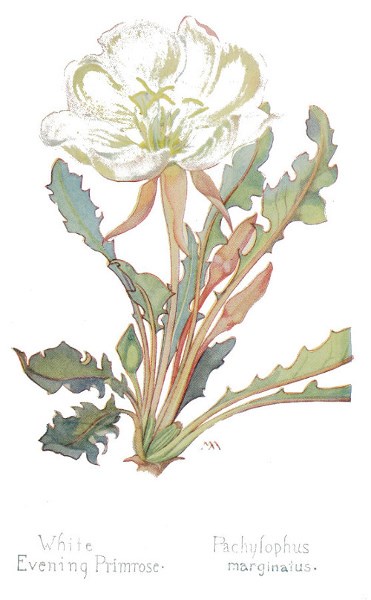
White Evening Primrose – Pachylophus marginatus.
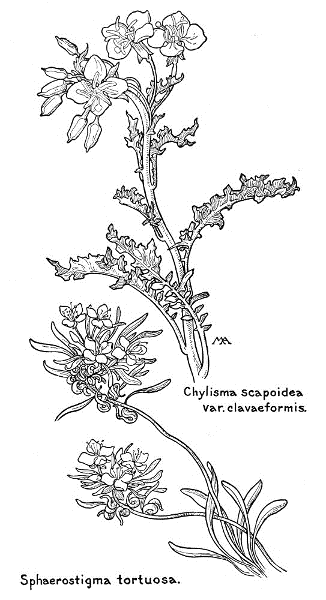
Chylisma scapoidea var. clavaeformis.
Sphaerostigma tortuosa.
There are several kinds of Anogra, resembling Onagra, but with white or pink flowers and the seeds differently arranged; the stems often clothed with papery bark; the buds drooping. The name is an anagram of Onagra.
Prairie Evening Primrose
Anogra albicàulis. (Oenothera)
White
Spring, summer
Southwest, etc.
A conspicuous kind, often growing in large patches, with whitish, downy, branching stems, from a few inches to a foot tall, often with shreddy bark, and downy, pale bluish-green leaves, more or less toothed. The drooping, downy buds are tinted with reddish-pink and the lovely flowers are from one and a half to three inches across, with pure white petals, tinted with yellow at base, changing to pink after pollination and fading to crimson. The stamens have cobwebby threads, white filaments, and yellow anthers, the pistil is green and the curved capsule is downy or hairy. The whole color scheme, of pale sea-green foliage, reddish buds, and white, rose-color, and crimson flowers, is delicate, harmonious, and effective. This grows in sandy places, and on the prairies from Dakota to Mexico.
Cut-leaved Evening Primrose
Anogra coronopifòlia (Oenothera)
White
Summer, autumn
Ariz., Utah, etc.
A pretty plant, with an erect, leafy stem, six inches to two feet tall, springing from running rootstocks, and pale green, more or less downy, leaves, finely cut into numerous, small, narrow lobes, so that they look like rather dry little ferns. The delicate flowers are the usual Evening Primrose shape, about an inch across, in the axils of the leaves, with pure white petals, greenish at the base and turning pink in fading, and a calyx-tube two inches long, with turned-back, pinkish-green lobes. The anthers are brown, the pistil green, the throat of the corolla is closed by a fringe of white hairs, the buds are drooping and the capsule is oblong and hairy. This is common on prairies and plains, from Nebraska to Utah, and south to New Mexico, reaching an altitude of nine thousand feet.
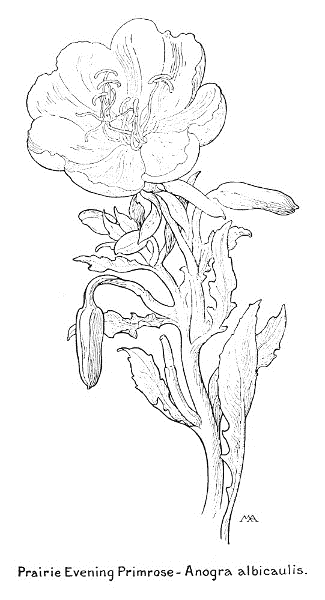
Prairie Evening Primrose – Anogra albicaulis.
There are several kinds of Onagra, differing from Anogra in having yellow flowers and in the arrangement of the seeds; with stems; leaves alternate, with wavy or toothed margins; buds erect; flowers night-blooming, in terminal clusters; calyx-tube long; petals four; stamens eight, equal in length; stigma four-cleft; capsule four-angled, more or less tapering.
Evening Primrose
Ónagra Hóokeri (Oenothera)
Yellow
Summer
West
A fine biennial, with stout, leafy stems, from three to six feet high, bearing splendid flowers, over three inches across, with clear yellow petals, fading to pink, and reddish calyx-lobes. The leaves, stems, and buds all downy and the buds erect. The stigma has four, slender lobes, forming a little cross, and the yellow pollen is loosely connected by cobwebby threads, clinging to visiting insects, and is thus carried from flower to flower; the capsule is an inch long. This is much handsomer than the common Evening Primrose, O. biénnis, and especially fine in Yosemite. As the mountain shadows begin to slant across the Valley the blossoms commence to open, until the meadows are thickly strewn with "patens of bright gold." They stay open all night, withering with the noonday sun.
There are several kinds of Lavauxia; low, usually stemless; leaves mostly from the root; calyx-tube slender; petals four; stamens eight, the alternate ones longer; ovary short, stigma four-cleft; capsule stout, four-angled or winged.
Sun-cups
Lavaùxia primivèris (Oenothera)
Yellow
Spring
Arizona
An attractive little plant, in the desert, with no stem, the flowers with long, slender calyx-tubes, resembling stems, springing from a clump of rather downy root-leaves. The buds are hairy and the flowers are about an inch across, light yellow, with pale yellow stamens and stigma. This plant varies a good deal in size, bearing one or several flowers, and the margins of the leaves almost toothless or irregularly slashed. It superficially resembles Taráxia ovàta, the Sun-cups so common on the southwestern coast, for the flowers have the same little fresh, sunny faces, but the latter has a round-topped stigma.
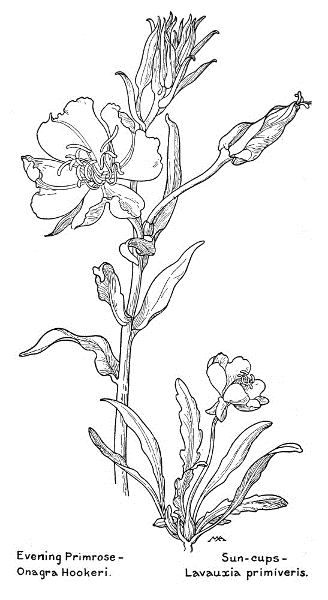
Evening Primrose – Onagra Hookeri.
Sun-cups – Lavauxia primiveris.
PARSLEY FAMILY. Umbelliferae
A large family, widely distributed, not abundant in the tropics; usually strong-smelling herbs, remarkable for their aromatic oil, mostly with hollow, grooved stems; leaves alternate, compound, generally deeply cut, leaf-stalks often broadened at base; flowers very small, usually in broad, flat-topped clusters, generally with bracts; calyx usually a five-toothed rim around the top of the ovary; petals five, small, usually with tips curled in, inserted on a disk, which crowns the ovary and surrounds the base of the styles; stamens five, with threadlike filaments and swinging anthers, also on the disk; ovary two-celled, inferior, with two threadlike styles; fruit two, dry, seedlike bodies, when ripe separating from each other, and usually suspended from the summit of a slender axis, each body marked with ribs, usually with oil-tubes between the ribs. The examination of these oil-tubes in mature fruits, with a microscope, is necessary to determine most of the genera and species, so description of genera is omitted here, and botanists have added to the difficulties of the amateur by giving almost every genus more than one name. The flowers are much alike, yet the leaves often differ very much in the same genus. Many kinds are poisonous, although others, such as Parsley, Carrot, and Parsnip, are valuable food plants.
Peucédanum Euryptèra
Yellow
Spring
California
A fine robust plant, a foot or more tall, with stout, purplish stems and smooth, crisp leaves, the lower ones with three leaflets, the upper with five, and the teeth tipped with bristles. The flowers are greenish-yellow and the main cluster measures four or five inches across, with no bracts at base, but the small clusters have bracts. The flowers are ugly, but the foliage is handsome and the seed vessels richly tinted with wine-color, making the plant decorative and conspicuous on the sea cliffs of southern California.
Turkey Peas
Orogènia linearifòlia
White
Spring
Northwest and Utah
A quaint little plant, only about three inches high, with a tuberous root, spreading, slanting stems, and smooth leaves, all from the root, with three, long, narrow leaflets; a reddish, stiff, papery scale sheathing the stem at base. The minute, white flowers form a cluster less than an inch across, without bracts, with a stout, ridged flower-stalk and composed of from two to ten smaller clusters, with small bracts; the anthers red. This grows in rich moist soil, in shady valleys, on mountain ridges; in the Wasatch Mountains, sometimes on the edge of the snow.
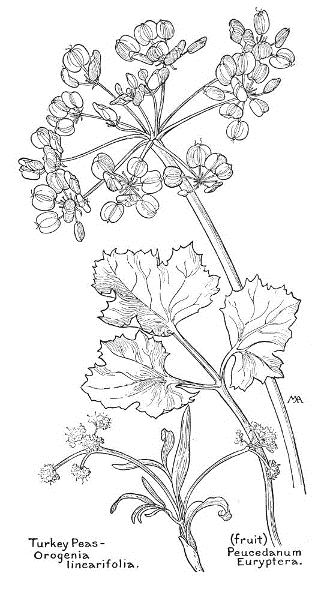
Turkey Peas – Orogenia linearifolia.
(fruit) Peucedanum Euryptera.
Pterýxia Califórnica (Cymópterus)
Yellow
Summer
Cal., Oreg.
Over a foot tall, with very pretty, dark green foliage and rather ugly, dull yellow flowers, in flat-topped clusters, three inches across. The leaves are in a cluster at the root, with long leaf-stalks sheathing at base, very finely cut and toothed, with stiffish points; the main flower-cluster without bracts, but the smaller clusters with narrow bracts.
Whisk-broom Parsley
Cogswéllia platycàrpa (Peucedanum simplex)
Yellow
Spring
Northwest and Utah
An odd-looking plant, for the foliage looks like pieces of a whisk-broom stuck in the ground. It is six to fourteen inches tall, with a thickish root and minute, sulphur-yellow flowers, forming a flat-topped cluster, about two inches across, without bracts, and composed of three to fifteen smaller clusters, with small bracts; usually only the outermost flowers of both the large and small clusters are fertile. The stem and leaves are stiff and sage-green, the root-leaves with broad leaf-stems, reddish and papery at base, sheathing the stem, and all the leaves cut into narrow divisions, not much thicker than pine needles, folded together so that they appear to be cylindrical. This grows on dry gravelly hills, at an altitude of from six to eight thousand feet.
Leptotaènia multífida (Ferula)
Yellowish-greenSpring, summer
Northwest, Nev., Utah, New Mex.
A fine, stout plant, about two feet tall, with a thick, spindle-shaped root and dark, rich-green, feathery foliage; the large leaves, over a foot long, appearing smooth but really imperceptibly downy, finely cut and lobed, with long, stout leaf-stalks; the small flowers, yellowish-green or bronze-color, in flat-topped clusters, two or three inches across, with few or no bracts, with tall, stout flower-stalks, and composed of about eighteen, small clusters, forming round knobs, with many bracts, on slender pedicels of various lengths. This grows in rich soil and is conspicuous on account of its size and foliage.

Pteryxia Californica.
Whisk-broom Parsley – Cogswellia platycarpa.
Velaèa argùta
Yellow
Spring
California
This has a stout, brownish stem, about eight inches tall, and fine, conspicuous foliage, mostly in a clump at the base, the leaves rich-green and very glossy, stiff and crisp in texture, though not thick, with bristle-tipped teeth. The rather ugly little flowers are greenish-yellow and the main cluster has no bracts. This grows in canyons in southern California.
Purple Sanicle, Nigger-babies
Sanícula bipinnatífida
Purplish
Spring, summer
Cal., Oreg.
This has branching, purplish stems, from six inches to three feet tall, and handsome foliage. The flowers are maroon-color and are crowded into balls, less than half an inch across, forming a loose, irregular cluster, with leafy bracts at the base. The effect of the dark flowers and fine foliage is rather attractive and it is common on grassy slopes in the hills.
Eulòphus Bolánderi
White
Summer
Northwest
This has a smooth, stiff stem, one to two feet tall, the leaves cut into long, narrow divisions, and the flowers very small, cream-white or pinkish, forming a flat-topped cluster, about two inches across, with narrow, pale bracts. This is quite pretty and common in Yosemite.
Indian Parsnip
Aulospérmum lóngipes (Cymopterus)
Yellow
Spring
Utah, Col., Wyo.



